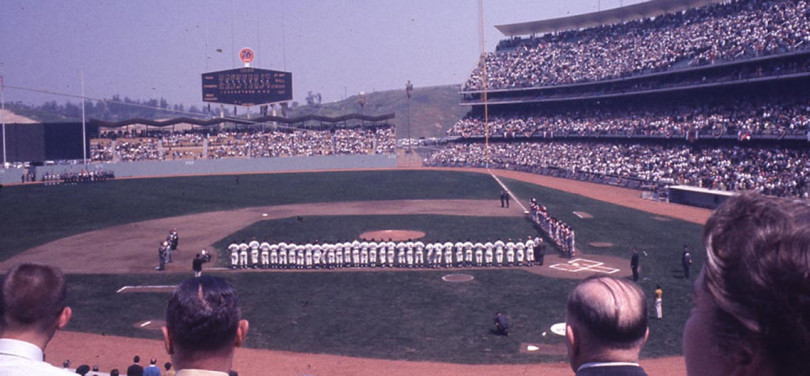
Reference Biography: Walter O’Malley
L.A.'s Sparkling New Jewel Opens
Opening Day finally arrived with all of its excitement and anticipation in Los Angeles, as O’Malley’s dream stadium took center stage. One day prior to Dodger Stadium’s public unveiling, a special invitation-only dedication ceremony was held for sponsors, politicians, key team executives and the media. The Grand Opening dedication ceremonies began on the steps of City Hall in Los Angeles, followed by a parade to the ballpark. Ford C. Frick, the Commissioner of Baseball, made a speech in which he called O’Malley a man “with the courage, imagination and stamina to move a mountain. When you see that thing out there, that stadium, then you will visualize the answer to some of those crybabies who say baseball is dying.” Walter Bingham, Sports Illustrated, April 23, 1962 Once the dignitaries arrived at Dodger Stadium for additional on-field ceremonies, all were in awe of its beauty with its colorful seats and unique column-free construction, so unlike other ballparks of the time.
This was a modern stadium built for baseball and not multi-purpose in conjunction with other sports. There were even an equal number of women’s powder rooms, 24, to men’s restrooms — an unheard of ratio in stadium building annals.
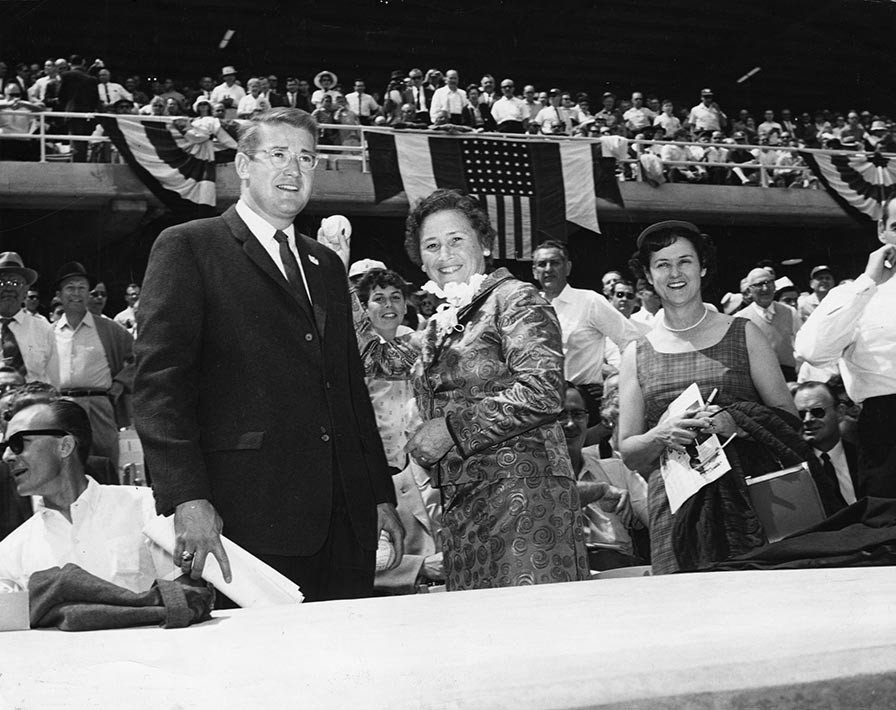
On Opening Day of Dodger Stadium, April 10, 1962, Peter O’Malley looks on as his mother Kay gets ready to throw out the ceremonial first pitch using an autographed team baseball from behind the Dodger dugout in the Field Level seats.
Kay O’Malley was selected to throw the ceremonial first pitch on Opening Day, which she did using an team autographed baseball from behind the Dodger dugout on the Field Level to catcher John Roseboro. Kay and Walter’s son Peter stood by her side. The Dodgers selected Latina diva Alma Pedroza to sing the national anthem. It christened the stadium which, since 1962, has provided nearly 150 million fans through the 2023 season, countless hours of fun, excitement and great memories.
The First Lady of the Dodgers was the perfect choice to immortalize Dodger Stadium. She was by her husband’s side each and every step of the way, from the bold move from Brooklyn to establishing their new home in Los Angeles. She kept a scorebook with details of every game (both at home and when the team was on the road). Kay’s only funny mistake in scorekeeping was that when Brooklyn friend Ed McLoughlin taught her the player position numbers he reversed the right fielder and the left fielder. Thus, the position numbers of 7 and 9 were incorrect in her book. Bob Hunter, The Sporting News, June 15, 1968 The lyric “You’ve Gotta Have Heart” from the popular Broadway hit, Damn Yankees, became her theme. Later, O’Malley presented her with a 1963 World Championship ring, which he made into a charm with a gold heart and the inscription, “You Gotta Have Heart.”
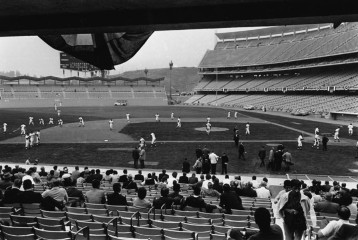
Fans arrive early on the morning of April 10, 1962 for the Opening Day at Dodger Stadium.
AP Photo/Don Brinn
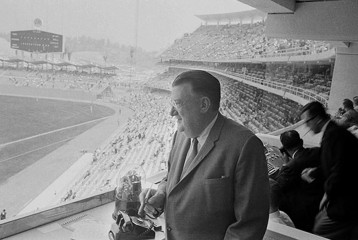
Walter O’Malley takes in the view from the press box of his new privately-financed $23 million palace – Dodger Stadium – on Opening Day, April 10, 1962.
AP Photo/Don Brinn
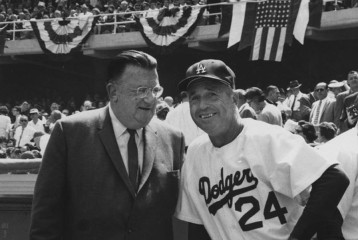
Walter O’Malley and Manager Walter Alston are ready for the opening of Dodger Stadium on April 10, 1962.
Mrs. Dearie Mulvey, the daughter of former Brooklyn Dodger part-owner Steve McKeever, was also honored at Dodger Stadium’s Opening Day and had the unique status of having attended both the Grand Opening of the new ballpark as well as witnessing the first game at Ebbets Field on April 9, 1913 with her father. Unfortunately, the Dodgers lost both home openers at their new ballparks with Mrs. Mulvey, still a partial stockholder, in attendance. Jack Butler, The Tablet newspaper, April 21, 1956
While two oversights in the newly-opened Dodger Stadium became fodder for the media, O’Malley and his team immediately worked to correct both. The first was that only two drinking fountains in the dugouts were in place for Opening Day and the press called this oversight “O’Malley’s Oasis.” However, the construction team had simply run out of time and, already in the works, this was instantly resolved and the appropriate drinking fountains were added to all levels. A week after the first game, only six complaint letters had been sent to the Dodger offices on the topic according to executive Red Patterson. The second issue was more cumbersome, as the foul poles, which normally are placed in “fair” territory were actually located in foul territory. For the 1962 season only, the Dodgers received special dispensation from the National League to leave them in place. The following season, they were moved to the proper location. But, while there was some ribbing in the media about the stadium, fans were giving their new surroundings high marks, as they flocked to the ballpark in record numbers. That season the Dodgers attracted 2,755,184 fans, a major league record.
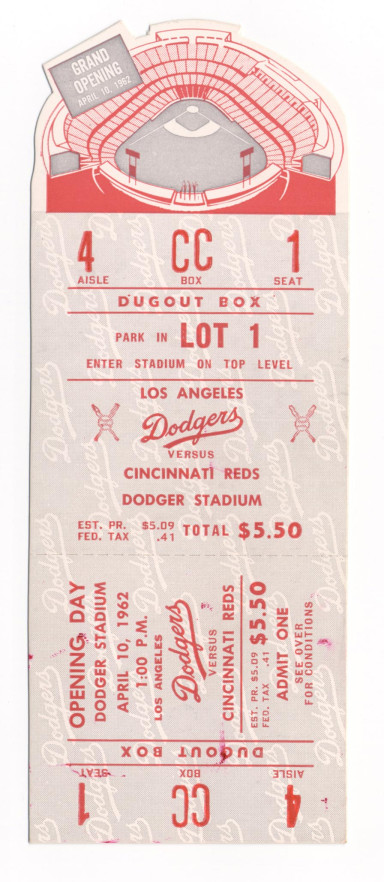
The Opening Day 1962 ticket features a special die-cut design of the new Dodger Stadium.
As a stickler for cleanliness, O’Malley ensured that one could practically eat off the floors at Dodger Stadium. The sparkling concrete floors welcomed fans through the walkways to their colorful seats. The 48 restrooms, more than at any other ballpark, were equally well-kept. In Los Angeles, the concession stands were large and accessible. The entire experience was family-friendly in a comfortable, safe and clean environment at Dodger Stadium, where the game was the star. Traditional organ music and large informational scoreboards enhanced fan enjoyment. Extensive plantings, signature swaying palm trees, colorful flowers and exotic landscaping around Dodger Stadium and its surrounding hillsides were immaculately maintained, adding to the first-class image and brand name the Dodgers were to sustain throughout the O’Malley regime.
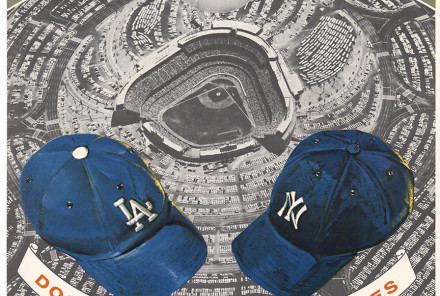
The Dodgers were on their way to the 1962 National League Pennant and a World Series date with the New York Yankees. The San Francisco Giants, though, spoiled the party by winning a three-game playoff series, including the final game at Dodger Stadium. This was a “phantom” 1962 World Series program cover that the Dodgers had printed.
Copyright © Los Angeles Dodgers, Inc.
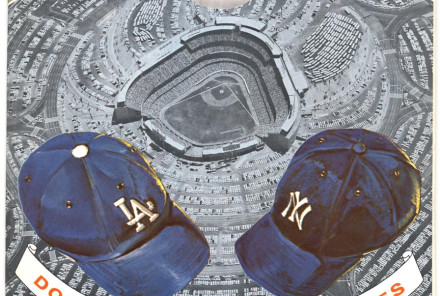
With the same program cover design as the previous year, the 1963 World Series featured a four-game sweep by the Dodgers over their October rivals, the New York Yankees. The Dodgers won Game 4 at Dodger Stadium, 2-1, behind pitcher Sandy Koufax, the Series MVP.
Copyright © Los Angeles Dodgers, Inc.
A time capsule was placed at Dodger Stadium, and according to official documents it includes the following collectibles: sports pages of April 8-12, 1962; Yearbooks — one for each year of the Dodgers in Los Angeles; World Series program for 1959 and the All-Star Game program from Los Angeles in 1959; Scorecards — one for each year of the Dodgers in Los Angeles, including the first 1962 scorecard; stories on the Grand Opening ceremonies from the Los Angeles Times and Herald Examiner; some pictures of the largest crowd in baseball history, the exhibition game between the Dodgers and New York Yankees, the 1959 World Series, team pictures of the 1959 World Champion Dodgers and Sandy Koufax’s 18-strikeout game; and a story on the Referendum victory. Also included are a city charter; a 1962 county budget; county charter; official ribbon from Grand Opening, April 9, 1962; a list of members on the Citizens Committee; a program from April 9, 1962; Governor’s statement; and agenda for the city and county, April 9 & 10, 1962.
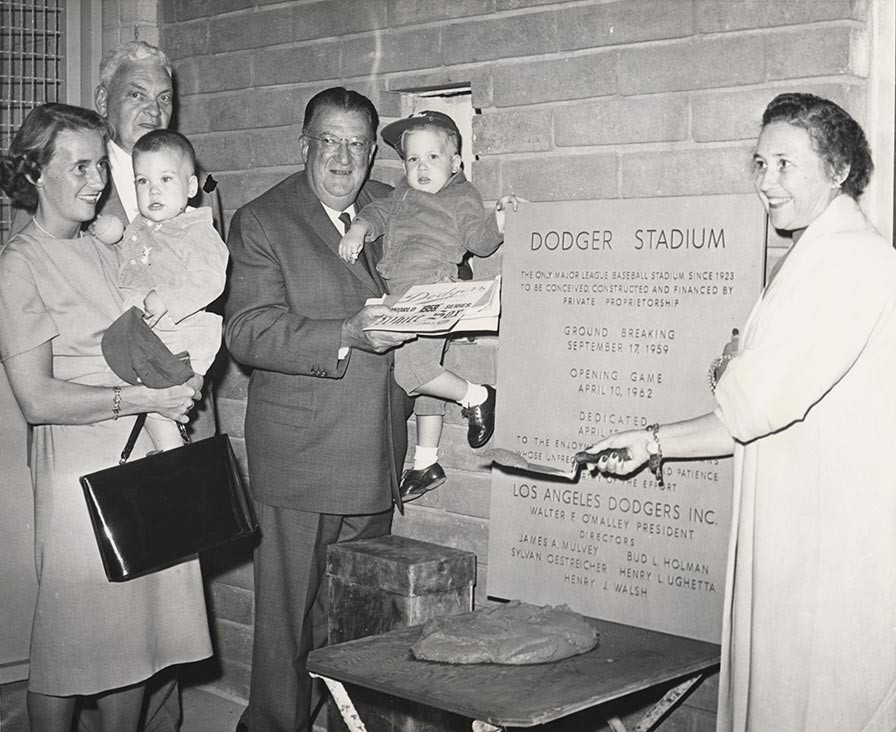
Dedication ceremonies of Dodger Stadium on April 12, 1962; (l-r) Terry O’Malley Seidler holding her son Peter, Capt. Emil Praeger, Walter O’Malley holding Terry’s son John and Kay O’Malley. A dedication plaque is located on the Top Deck level.
The 1962 season ended in a three-game playoff series with the rival Giants. The Dodgers won 102 games in 1962, their most victories since 105 in 1953. After losing the first playoff game in Candlestick Park, 8-0, the Dodgers won the second game in Los Angeles, 8-7. But, the Giants took the decisive contest, 6-4, with old nemesis Don Larsen earning the come-from-behind victory (trailing 4-2 in the ninth inning) to disappoint Dodger fans and bring back painful memories of 1951. That season in New York, O’Malley went to the Giants’ clubhouse to offer his congratulations to the winners. On this 1962 shocking day for the Dodgers, O’Malley immediately asked his son Peter to take a flight to San Francisco and personally return a block of World Series tickets. As he was fond of saying and related to Peter at that moment, “It’s tough to do, but you have to do the right thing.” He also hosted the Dodger front office executives and their spouses at one game of the World Series in San Francisco. The next day, meetings and planning began as the focus started on winning in 1963.
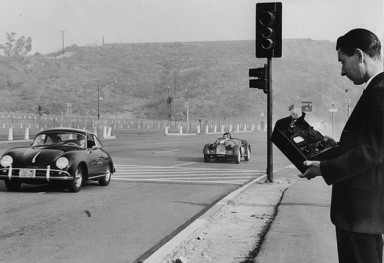
In addition to baseball, Dodger Stadium was used for other sporting events. A planned first event was a road race on March 2 and 3, 1963, taking advantage of the spacious parking lot around the ballpark. Robert E. Egan, Senior Investigator for the City’s Department of Building and Safety checks the noise level of sports cars in the parking lot as the Dodgers seek a permit for the races. Photo taken Nov. 21, 1962.
Los Angeles Times Collection, UCLA Library Special Collections
On March 2 and 3, 1963, O’Malley held the first non-baseball sporting event at Dodger Stadium, the 1st Dodger Stadium Sports Car Races in the parking lot. The races attracted an estimated 11,500 the first day with two bleacher seating areas set up in the parking lot. The Dodgers had to get the permission of the city to grant a three-year variance to permit sports car racing on the private roads and parking lots located at Dodger Stadium. It was the first of many experiments of using Dodger Stadium as a venue for other sporting activities. For instance, on February 2, 1964, O’Malley welcomed the world-famous Harlem Globetrotters to his venue and a crowd of 12,405 roared with laughter at the antics of Meadowlark Lemon and Co. against the outmanned Atlantic City Seagulls (The ’Trotters prevailed, 46-35). The basketball court (previously used by the L.A. Jets) was placed across home plate from the first and third base dugouts. According to newspaper reports, “fans even in the fourth deck had no trouble seeing or hearing the comments of leather-lunged Lemon and (Tex) Harrison.” John Hall, Los Angeles Times, February 3, 1964

